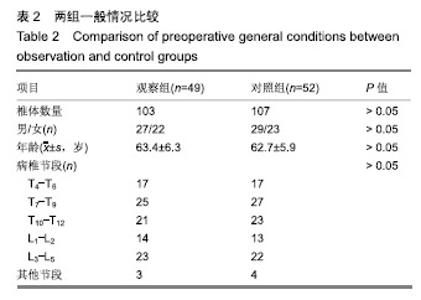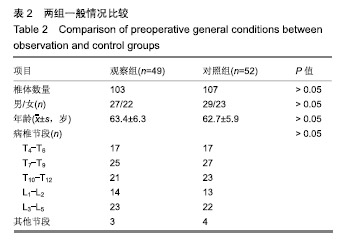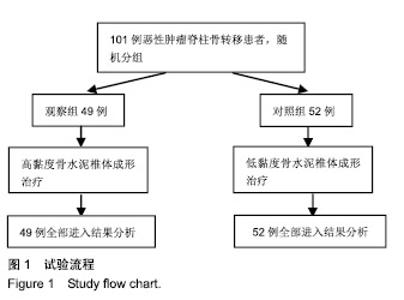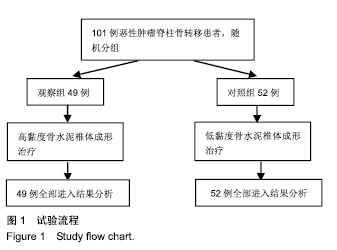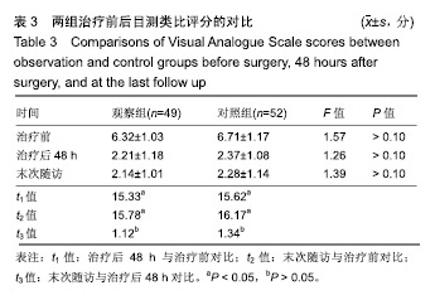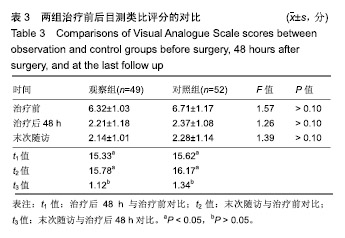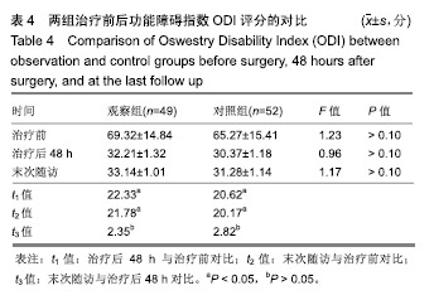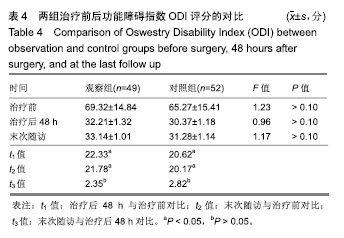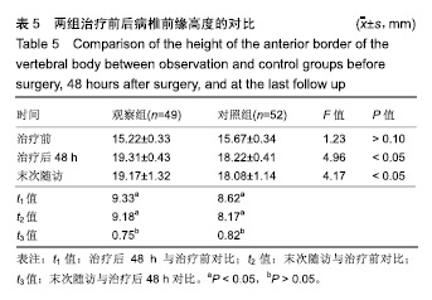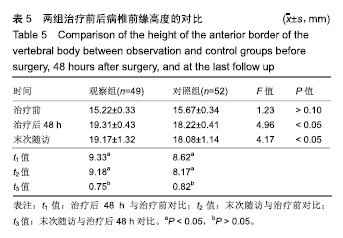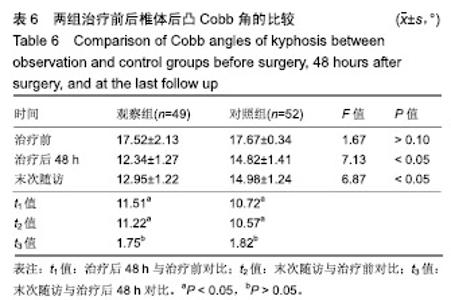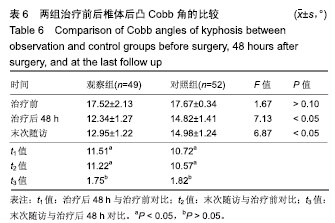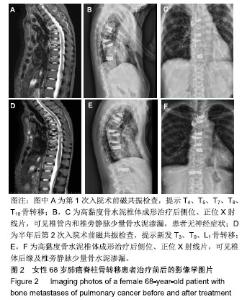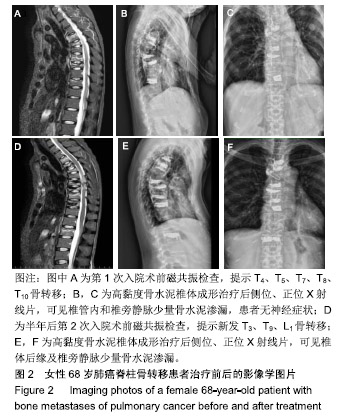Chinese Journal of Tissue Engineering Research ›› 2019, Vol. 23 ›› Issue (26): 4129-4135.doi: 10.3969/j.issn.2095-4344.1348
Previous Articles Next Articles
Percutaneous vertebroplasty with different viscosities of bone cement for treatment of thoracolumbar metastases
- Department of Orthopedics, Fifth Hospital in Wuhan (the Second Affiliated Hospital of Jianghan University), Wuhan 430050, Hubei Province, China
-
Received:2019-04-24 -
Contact:Li Minghui, Department of Orthopedics, Fifth Hospital in Wuhan (the Second Affiliated Hospital of Jianghan University), Wuhan 430050, Hubei Province, China -
About author:Li Minghui, MD, Associate chief physician, Department of Orthopedics, Fifth Hospital in Wuhan (the Second Affiliated Hospital of Jianghan University), Wuhan 430050, Hubei Province, China -
Supported by:Hubei Provincial Health Planning Commission Project, No. WJ2015Z070 (to LMH)
CLC Number:
Cite this article
Li Minghui, Liu Yang, Zhang Mi, Xu Feng . Percutaneous vertebroplasty with different viscosities of bone cement for treatment of thoracolumbar metastases [J]. Chinese Journal of Tissue Engineering Research, 2019, 23(26): 4129-4135.
share this article
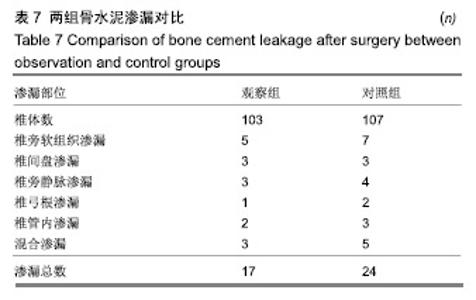
2.8 材料宿主反应 两组患者随访期间均无邻近椎体骨折、无肺栓塞发生。 骨水泥渗漏:①观察组103个椎体术后影像学检查发现17个椎体周缘出现渗漏,渗漏发生率为16.50%,其中5个椎体出现单纯椎旁软组织渗漏,3个为单纯椎间盘渗漏, 3个为单纯椎旁静脉渗漏,1个为单纯椎弓根内渗漏,椎管 内渗漏2例(1例发生在胸椎,患者无神经症状;1例发生在腰椎,术后出现下肢酸胀疼痛,给予非类固醇类消炎药口服,甘露醇脱水治疗1周后症状缓解),另有3个椎体属于混合渗漏(即存在椎旁软组织渗漏,又存在椎旁静脉或椎间盘渗漏);②对照组107个椎体术后影像学检查发现24个椎体周缘出现渗漏,渗漏发生率为22.43%,其中7个为单纯椎旁软组织渗漏,3个为单纯椎间盘渗漏,4个为单纯椎旁静脉渗漏,2个为单纯椎弓根内渗漏,3个为椎管内渗漏(均发生在腰椎,均无神经症状),另有5个属于混合渗漏,观察组骨水泥渗漏率低于对照组(P < 0.05),见表7,图2。"
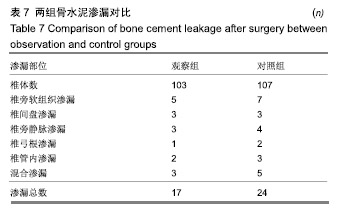
| [1]Li Y,Qing Y,Zhang Z,et al.Clinical efficacy of percutaneous vertebroplasty combined with intensity-modulated radiotherapy for spinal metastases in patients with NSCLC. Onco Targets Ther. 2015; 8:2139-2145.[2]Yang Z,Tan J,Zhao R,et al.Clinical Investigations on the Spinal Osteoblastic Metastasis Treated by Combination of Percutaneous Vertebroplasty and 125I Seeds Implantation Versus Radiotherapy. Cancer Biother Radiopharm. 2013; 28(1):58-64.[3]Mansoorinasab M,Abdolhoseinpour H.A review and update of vertebral fractures due to metastatic tumors of various sites to the spine: Percutaneous vertebroplasty.Interv Med Appl Sci. 2018;10(1): 1-6. [4]Liu Y,Wang Y,Zhao L,et al.Effectiveness and safety of percutaneous vertebroplasty in the treatment of spinal metastatic tumor.Pak J Med Sci.2017;33(3):675-679.[5]Gu YF,Tian QH,Li YD,et al.Percutaneous vertebroplasty and interventional tumor removal for malignant vertebral compression fractures and/or spinal metastatic tumor with epidural involvement: a prospective pilot study.J Pain Res. 2017;10:211-218.[6]Su Y,Sun ZZ,Shen LX,et al.Comparison of percutaneous vertebroplasty with and without interventional tumor removal for spinal metastatic tumor without epidural involvement.J Bone Oncol.2017;6:1-7.[7]Qi L,Li C,Wang N,et al.Efficacy of percutaneous vertebroplasty treatment of spinal tumors: A meta-analysis. Medicine (Baltimore).2018;97(3):e9575.[8]闫光华,葛顺杰,仇继任,等.经皮椎体成形骨水泥渗漏的治疗与预防[J].中国组织工程研究,2018,22(26):4241-4246.[9]Martins PC,Couto TE,Gama AC.Auditory perceptual evaluation of the degree vocal deviation: correlation between the Visual Analogue Scale and Numerical Scale.Codas. 2015; 27(3):279-284.[10]Monticone M,Baiardi P,Vanti C,et al.Responsiveness of the Oswestry Disability Index and the Roland Morris Disability Questionnaire in Italian subjects with sub-acute and chronic low back pain.Eur Spine J.2012;21(1):122-129.[11]Masala S,Anselmetti GC,Muto M,et al.Percutaneous Vertebroplasty Relieves Pain in Metastatic Cervical Fractures.Clin Orthop Relat Res.2011;469(3):715-722.[12]Jansson KA,Bauer HC.Survival,complications and outcome in 282 patients operated for neurological deficit due to thoracic or lumbar spinal metastases.Eur Spine J.2006;15(2):196-202. [13]Polastri M,Gasbarrini A.Vertebroplasty in patients with tumour-related vertebral fractures: is rehabilitation needed? Asian Spine J.2013;7(3):248-252.[14]Ma XL,Xing D,Ma JX,et al.Balloon kyphoplasty versus percutaneous vertebroplasty in treating osteoporotic vertebral compression fracture: grading the evidence through a systematic review and meta-analysis.Eur Spine J. 2012;21(9): 1844-1859.[15]杨学刚,吴戈,李政文,等.骨填充网袋辅助经皮椎体成形术治疗伴椎体后壁破损的脊柱转移瘤[J].介入放射学杂志, 2017,26(9): 803-806.[16]De la Garza-Ramos R,Benvenutti-Regato M,Caro-Osorio E.Vertebroplasty and kyphoplasty for cervical spine metastases: a systematic review and meta-analysis.Int J Spine Surg.2016;10:7. [17]Sadeghi-Naini M,Aarabi S,Shokraneh F,et al.Vertebroplasty and Kyphoplasty for Metastatic Spinal Lesions:A Systematic Review.Clin Spine Surg.2018;31(5):203-210. [18]王伟军.高黏度与低黏度骨水泥椎体成形术治疗骨质疏松性椎体压缩骨折有效性的Meta分析[J].中华创伤杂志, 2018,34(9): 806-812.[19]陈秋洪,胡炳树,李杰,等.经皮椎体成形术治疗脊柱转移瘤的疗效评估[J].中国骨与关节杂志,2018,12(9):681-686.[20]Farrokhi M,Nouraei H,Kiani A.The Efficacy of Percutaneous Vertebroplasty in Pain Relief in Patients with Pathological Vertebral Fractures due to Metastatic Spinal Tumors.Iran Red Crescent Med J.2012;14(9):523-530.[21]Liang L,Chen X,Jiang W, et al.Balloon kyphoplasty or percutaneous vertebroplasty for osteoporotic vertebral compression fracture? An updated systematic review and meta-analysis.Ann Saudi Med.2016;36(3):165-174.[22]He Z,Zhai Q,Hu M,et al.Bone cements for percutaneous vertebroplasty and balloon kyphoplasty: Current status and future developments.J Orthop Translat.2015;3(1):1-11.[23]Liu W,Zhou S,Wang S.Application of percutaneous vertebroplasty in the treatment of multiple thoracic metastases. Oncol Lett.2015;9(6):2775-2780.[24]Guo D,Cai J,Zhang S,et al.Treating osteoporotic vertebral compression fractures with intraosseous vacuum phenomena using high-viscosity bone cement via bilateral percutaneous vertebroplasty. Medicine(Baltimore).2017;96(14):e6549.[25]Ate? A,Gemalmaz HC,Deveci MA,et al.Comparison of effectiveness of kyphoplasty and vertebroplasty in patients with osteoporotic vertebra fractures.Acta Orthop Traumatol Turc.2016;50(6):619-622.[26]张伟,杨金华,黄开,等.PKP与高粘度骨水泥PVP治疗骨质疏松性椎体压缩骨折的疗效比较[J].中国骨与关节损伤杂志, 2017, 32(11):1138-1140.[27]曾森炎,季卫锋,董玉鹏,等.高粘度与低粘度骨水泥PVP治疗骨质疏松性椎体压缩骨的Meta分析[J].中国骨与关节损伤杂志, 2018,33(3):240-243.[28]徐敏,张鸿升,王继,等.高黏度与低黏度骨水泥经皮椎体成形治疗骨质疏松椎体压缩性骨折的Meta分析[J].中国组织工程研究, 2017,21(34):5571-5576.[29]唐冲,吴四军,刘正,等.高粘度骨水泥经皮椎体成形术治疗骨质疏松性椎体压缩骨折的疗效分析[J].中国脊柱脊髓杂志, 2017, 27(8):720-726.[30]Yuan WH, Hsu HC,Lai KL.Vertebroplasty and balloon kyphoplasty versus conservative treatment for osteoporotic vertebral compression fractures: A meta-analysis.Medicine (Baltimore).2016;95(31):e4491.[31]Zeng TH,Wang YM,Yang XJ,et al.The clinical comparative study on high and low viscosity bone cement application in vertebroplasty.Int J Clin Exp Med.2015;8(10):18855-18860. |
| [1] | Huang Dengcheng, Wang Zhike, Cao Xuewei. Comparison of the short-term efficacy of extracorporeal shock wave therapy for middle-aged and elderly knee osteoarthritis: a meta-analysis [J]. Chinese Journal of Tissue Engineering Research, 2021, 25(9): 1471-1476. |
| [2] | Xu Feng, Kang Hui, Wei Tanjun, Xi Jintao. Biomechanical analysis of different fixation methods of pedicle screws for thoracolumbar fracture [J]. Chinese Journal of Tissue Engineering Research, 2021, 25(9): 1313-1317. |
| [3] | Lu Dezhi, Mei Zhao, Li Xianglei, Wang Caiping, Sun Xin, Wang Xiaowen, Wang Jinwu. Digital design and effect evaluation of three-dimensional printing scoliosis orthosis [J]. Chinese Journal of Tissue Engineering Research, 2021, 25(9): 1329-1334. |
| [4] | Zhang Tongtong, Wang Zhonghua, Wen Jie, Song Yuxin, Liu Lin. Application of three-dimensional printing model in surgical resection and reconstruction of cervical tumor [J]. Chinese Journal of Tissue Engineering Research, 2021, 25(9): 1335-1339. |
| [5] | Li Dadi, Zhu Liang, Zheng Li, Zhao Fengchao. Correlation of total knee arthroplasty efficacy with satisfaction and personality characteristics [J]. Chinese Journal of Tissue Engineering Research, 2021, 25(9): 1346-1350. |
| [6] | Wei Wei, Li Jian, Huang Linhai, Lan Mindong, Lu Xianwei, Huang Shaodong. Factors affecting fall fear in the first movement of elderly patients after total knee or hip arthroplasty [J]. Chinese Journal of Tissue Engineering Research, 2021, 25(9): 1351-1355. |
| [7] | Yao Rubin, Wang Shiyong, Yang Kaishun. Minimally invasive transforaminal lumbar interbody fusion for treatment of single-segment lumbar spinal stenosis improves lumbar-pelvic balance [J]. Chinese Journal of Tissue Engineering Research, 2021, 25(9): 1387-1392. |
| [8] | Wang Haiying, Lü Bing, Li Hui, Wang Shunyi. Posterior lumbar interbody fusion for degenerative lumbar spondylolisthesis: prediction of functional prognosis of patients based on spinopelvic parameters [J]. Chinese Journal of Tissue Engineering Research, 2021, 25(9): 1393-1397. |
| [9] | Lü Zhen, Bai Jinzhu. A prospective study on the application of staged lumbar motion chain rehabilitation based on McKenzie’s technique after lumbar percutaneous transforaminal endoscopic discectomy [J]. Chinese Journal of Tissue Engineering Research, 2021, 25(9): 1398-1403. |
| [10] | Chen Jinping, Li Kui, Chen Qian, Guo Haoran, Zhang Yingbo, Wei Peng. Meta-analysis of the efficacy and safety of tranexamic acid in open spinal surgery [J]. Chinese Journal of Tissue Engineering Research, 2021, 25(9): 1458-1464. |
| [11] | Gao Yan, Zhao Licong, Zhao Hongzeng, Zhu Yuanyuan, Li Jie, Sang Deen. Alteration of low frequency fluctuation amplitude at brain-resting state in patients with chronic discogenic low back pain [J]. Chinese Journal of Tissue Engineering Research, 2021, 25(8): 1160-1165. |
| [12] | He Li, Tian Wei, Xu Song, Zhao Xiaoyu, Miao Jun, Jia Jian. Factors influencing the efficacy of lumbopelvic internal fixation in the treatment of traumatic spinopelvic dissociation [J]. Chinese Journal of Tissue Engineering Research, 2021, 25(6): 884-889. |
| [13] | Wu Gang, Chen Jianwen, Wang Shilong, Duan Xiaoran, Liu Haijun, Dong Jianfeng. Simple HyProCure subtalar stabilization in treatment of adolescent flexible flatfoot combined with painful accessory navicular bone [J]. Chinese Journal of Tissue Engineering Research, 2021, 25(6): 901-905. |
| [14] | Li Yan, Wang Pei, Deng Donghuan, Yan Wei, Li Lei, Jiang Hongjiang. Electroacupuncture for pain control after total knee arthroplasty: a meta-analysis [J]. Chinese Journal of Tissue Engineering Research, 2021, 25(6): 957-963. |
| [15] | Zhang Wei, Hu Jiang, Tang Liuyi, Wan Lun, Yu Yang, Lin Shu, Tang Zhi, Wang Fei. Advantages of robot assisted percutaneous biopsy in the diagnosis of spinal lesions [J]. Chinese Journal of Tissue Engineering Research, 2021, 25(6): 844-848. |
| Viewed | ||||||
|
Full text |
|
|||||
|
Abstract |
|
|||||
